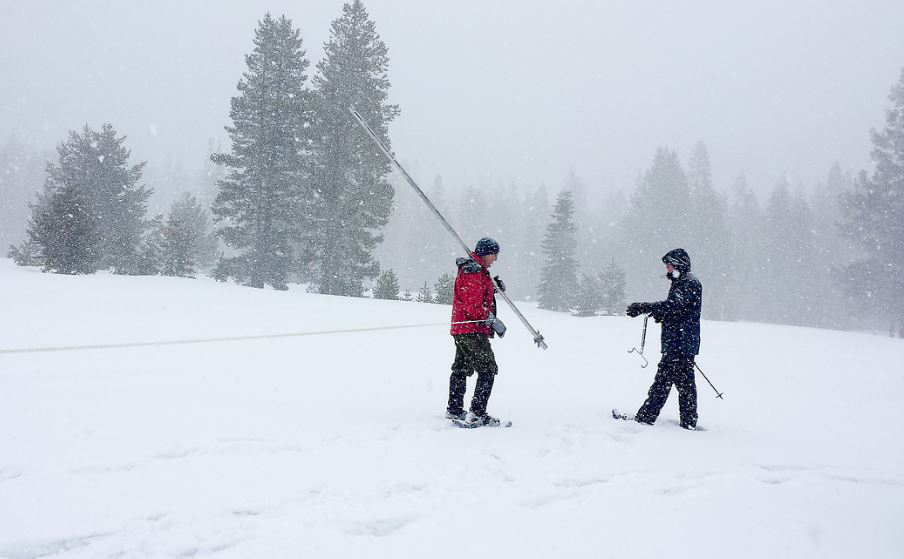
From left, Frank Gehrke, California Department of Water Resources, Chief of Snow Surveys and Nic Enstice, Sierra Nevada Conservancy, Regional Science Coordinator, conduct a snow survey at Phillips Station, Calif. on March 30, 2017. Maggie Macias / California Department of Water Resources
March 30, 2017 - SACRAMENTO – With every monthly measurement of the California snowpack this winter, the state’s rebound from the previous five years of drought becomes more evident. Today’s electronic readings from 95 sites in the Sierra Nevada show an average statewide snow water equivalent (SWE) of 45.8 inches, or 164 percent of the historical average for March 30 (27.9 inches).
April 2017 Manual Snow Survey
Posted by California Department of Water Resources on Thursday, March 30, 2017
Today’s manual snow survey by the Department of Water Resources (DWR) at Phillips Station in the Sierra Nevada found a SWE of 46.1 inches, 183 percent of the late March/early April long-term average at Phillips (25.2 inches). The three previous 2017 surveys at Phillips near the beginning of March, February and January found an SWE of 43.5 inches for March, 28 inches for February and 6 inches for January.
SWE is the depth of water that theoretically would result if the entire snowpack melted instantaneously. That measurement is more important than depth in evaluating the status of the snowpack. On average, the snowpack supplies about 30 percent of California’s water needs as it melts in the spring and early summer.
Electronic measurements indicate the water content of the northern Sierra snowpack is 40.8 inches, 147 percent of the multi-decade March 30 average. The central and southern Sierra readings are 50.5 inches (175 percent of average) and 43.9 inches (164 percent of average), respectively.
Dr. Michael Anderson, State Climatologist, observed: “Although the record pace of the snowpack accumulation fell off significantly in March, California enters the snowmelt season with a large snowpack that will result in high water in many rivers through the spring."
The Phillips snow course, near the intersection of Highway 50 and Sierra-at-Tahoe Road, is one of hundreds surveyed manually throughout the winter. Manual measurements augment the electronic readings from about 100 sensors in the state’s mountains that provide a current snapshot of the water content in the snowpack.
Frank Gehrke, chief of the California Cooperative Snow Surveys Program, conducted DWR’s survey today at Phillips and said of his findings, "The storm track shifted away from California during March, but we still have a very substantial snowpack, particularly in the higher elevations in the central and southern Sierra. This is an extremely good year from the snowpack standpoint,” he said, adding that this year’s snowpack ranks in the upper quarter of historic snowpacks and is providing “great reservoir recovery.”
Many Californians continue to experience the effects of drought, and some Central Valley communities still depend on water tanks and bottled water. Groundwater – the source of at least a third of the supplies Californians use – will take much more than even an historically wet water year to be replenished in many areas.
California’s climate is the most variable of any state. Historically, it swings from drought to flood and back to drought. In addition, as global warming drives up average temperatures in California, more precipitation will fall as rain, not as snow stored in the Sierra Nevada and other mountains. To help prepare for these ever-wider extremes, Californians can learn ways to save water every day by visiting SaveOurWater.com.
Source: DWR








